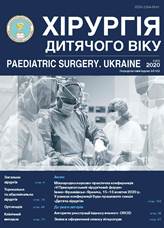Pilonidal disease in children: some links of etiopathogenesis of the disease (clinical observation)
DOI:
https://doi.org/10.15574/PS.2020.67.85Keywords:
pilonidal disease, children, etiology, pathogenesis, clinical caseAbstract
Pilonidal cyst of the tailbone is a common purulent-inflammatory disease that occurs in children of different age groups, often in adolescence in the form of an acute abscess. The disease is prone to recurrent course and requires radical surgical treatment during the period of remission. However, scientists still have contradictions both about this definition and about the causes of pilonidal disease. Now there are two main theories of the etiology and pathogenesis of pilonidal disease: theories of congenital origin (empirical theories, the theory of neurogenic origin, theories of ectodermal origin) and acquired genesis. The most «popular» and reasoned in recent years is the theory of acquired genesis. So, the acquired mechanism of occurrence is confirmed in the experiment. He proves the possibility of penetration into the cavity of the pilonidal cyst hair rods (fragments) from various parts of the body, dirt, desquamated epithelium, particles of foreign bodies, etc. However, in children with a histological examination of the removed macropreparation (after radical removal of the pilonidal cyst), elements were found in the thickness of the walls that prove the congenital cause of the occurrence of pilonidal disease.
As a vivid illustration of the versatility of the factors of the formation and course of pilonidal disease in children, we present a clinical example from our own practice. He argues the introduction of etiopathogenetically substantiated methods of surgical treatment of pathology. These methods are based on the principles of eliminating congenital (constitutional) factors that contribute to the formation of the disease: economical excision of soft tissues in the area of the interalogodic folds, leveling its depth and lateralization of the suture line.
The research was carried out in accordance with the principles of the Helsinki Declaration. The study protocol was approved by the Local Ethics Committee of participating institution. The informed consent of the patient was obtained for conducting the studies.
References
Achkasov EE, Solomka AYa, Ulyanov AA et al. (2018). Klinikomorfologicheskoe obosnovanie primeneniya trombotsitarnyih faktorov rosta u bolnyih s pilonidalnoy kistoy i abstsesom. Vestnik hirurgii. 177(2): 52–56. https://doi.org/10.24884/0042-4625-2018-177-2-52-56
Bosche FD, Luedi MM, van der Zypen D. (2017). The hair in the sinus: sharp-ended rootless head hair fragments can be found in large amounts in pilonidal sinus nests. World Journal of Surgery. 42(4): 93–95. https://doi.org/10.1007/s00268-017-4093-5; PMid:28639004
Doll D, Bosche FD, Stauffer VK et al. (2017). Strength of occipital hair as an explanation for pilonidal sinus disease caused by intruding hair. Diseases of the colon & rectum. 60(9): 979–986. https://doi.org/10.1097/DCR.0000000000000795; PMid:28796737
Doll D. (2019). Pilonidal sinus disease – 186 years since Mayo. Coloproctology. 2: 94–95. https://doi.org/10.1007/s00053-018-0315-z
Konoplitskyi VS, Shavliuk RV, Shavliuk VM. (2019). Pilonidalna khvoroba u ditei. Chy vsi pytannia patohenezu vyrisheni? Shpytalna khirurhiia. 3: 68–74. https://doi.org/10.11603/2414-4533.2019.3.10549
Lesalnieks I, Ommer A. (2019). The management of pilonidal sinus. Dtsch Arztebl Int. 116: 12–21. https://doi.org/10.3238/arztebl.2019.0012; PMid:30782310 PMCid:PMC6384517
Poverin GV, Evdokimov AN. (2019). Kistyi kopchika u detey (klinika, diagnostika i hirurgicheskoe lecheniya. Rossiyskiy vestnik detskoy hirurgii, anesteziologii i reanimatologii. 9(2): 105–120. https://doi.org/10.30946/2219-4061-2019-9-2-105-120
Rumyantseva GN, Kartashev VN, Gorshkov AYu et al. (2020). Neotlozhnaya hirurgicheskaya taktika pri nagnoivsheysya pilonidalnoy kiste kopchika. Detskaya hirurgiya. 24(1): 71.
Segre D, Pozzo M, Perinotti R, Roche B. (2015). Italian Society of Colorectal Surgery: The treatment of pilonidal disease: guidelines of the Italian Society of Colorectal Surgery (SICCR). Tech Coloproctol. 19: 607-613. https://doi.org/10.1007/s10151-015-1369-3; PMid:26377583
Tsema YeV. (2013). Evoliutsiia uiavlen pro etiopatohenez pilonidalnoi khvoroby. Khirurhiia Ukrainy. 2: 9–22.
Tsema YeV. (2017). Svitovi tendentsii v likuvanni pilonidalnoi khvoroby (epitelialnoho kuprykovoho khodu). Khirurhiia Ukrainy. 4: 7–16.
Warren JM. (1854). Abscess containing hair on the nates. Am J Med Sci. 28:113-117.
Yurkiv O, Tsema YeV. (2018). Suchasnyi pohliad na prychyny vynyknennia ta likuvannia pilonidalnykh ta dermoidnykh kisy kryzhovokuprykovoi dilianky. Ukrainskyi naukovo-medychnyi molodizhnyi zhurnal. 1: 30–37.
Downloads
Published
Issue
Section
License
The policy of the Journal “PAEDIATRIC SURGERY. UKRAINE” is compatible with the vast majority of funders' of open access and self-archiving policies. The journal provides immediate open access route being convinced that everyone – not only scientists - can benefit from research results, and publishes articles exclusively under open access distribution, with a Creative Commons Attribution-Noncommercial 4.0 international license(СС BY-NC).
Authors transfer the copyright to the Journal “PAEDIATRIC SURGERY.UKRAINE” when the manuscript is accepted for publication. Authors declare that this manuscript has not been published nor is under simultaneous consideration for publication elsewhere. After publication, the articles become freely available on-line to the public.
Readers have the right to use, distribute, and reproduce articles in any medium, provided the articles and the journal are properly cited.
The use of published materials for commercial purposes is strongly prohibited.

